In-house fulfillment: The pros and cons for scaling ecommerce retailers
Fulfillment might not be the sexiest subject — heck, not much of this stuff is — but it’s something that can make or break your ecommerce business. There are times when it might make sense to outsource your fulfillment, and others when you might want to bring it back in house.
Today we’re going to run through what this journey might look like, and when you might consider bringing fulfillment back in-house — just like Allen here:


Allen runs the successful SpyGuy.com, turning us all into James Bond, one GPS tracker at a time. He managed with in-house fulfillment for years. Then he outsourced. Now he’s ready to bring it back in-house again. Why? Let’s find out.
Fulfillment: Origins
Fulfillment wasn’t always quite as complicated as it is now. In fact, according to Kate Mortenson, Product Analyst at Linnworks, the complexity of ecommerce is “what has made the fulfillment process scary.”
Consider the case of a brick-and-mortar store before the rise of ecommerce. According to Kate, “Businesses would have some sort of point-of-sale system that would catalog inventory in real-time. In this instance, somebody walks into the store, purchases an item, and takes it with them. The system removes the item from the inventory.”
Reasonably straightforward, right? Well, when we factor in ecommerce, a sizable shift takes place. Kate continues: “With ecommerce, the lifecycle of inventory becomes a lot slower. A customer buys an item, you take their money, but you also have inventory in your possession — which makes the fulfillment process scary. You’re responsible for managing your physical goods, and you’re responsible for managing your electronic offerings all while working hard to keep customers delighted with your fulfillment speed and accuracy.”
It’s these challenges, at least in part, that led to the rise of third party logistics (3PL) providers. They are designed to handle order fulfillment on behalf of retailers — for a fee. Let’s look at when it might make sense to outsource to a 3PL.
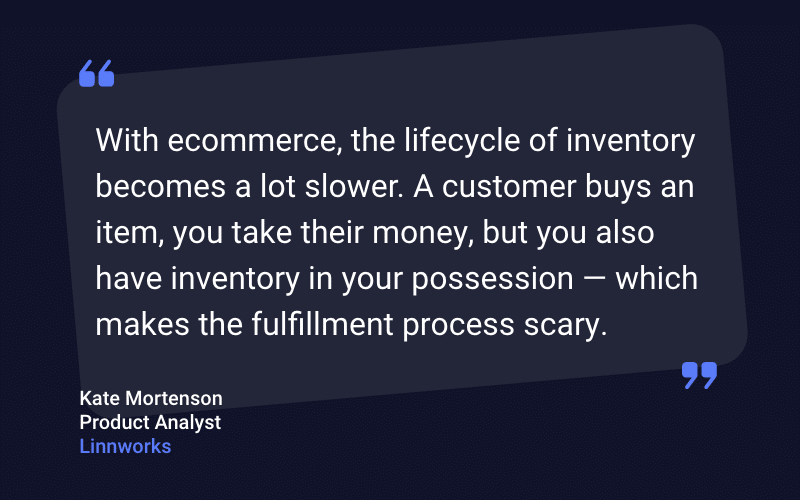
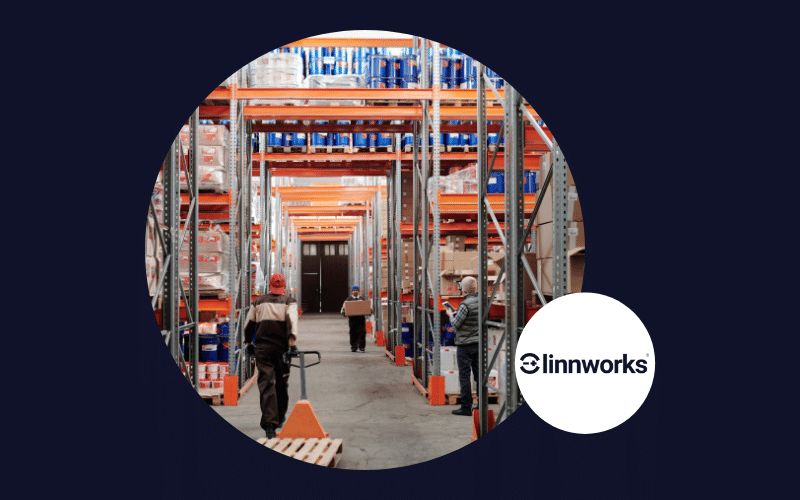
Why would you even outsource your fulfillment?
Outsourcing fulfillment has become a popular choice for businesses seeking streamlined processes and cost efficiency. In fact, 57% of ecommerce businesses outsource some if not all of their fulfillment processes.
Here are some of the benefits:
- Potential cost savings: Fulfillment centers, equipped with their economies of scale, can handle large volumes efficiently, and can reduce operational costs for businesses.
- Access to Expertise: Fulfillment providers employ professionals well-versed in logistics, giving you access to their knowledge and ensuring seamless order processing, inventory management, and shipping logistics.
- Flexibility: Outsourcing can offer flexibility, allowing businesses to scale operations swiftly based on market demands without the burden of managing an in-house team.
And just like that. Poof. Fulfillment headaches gone, right? Well, maybe not. Enter our friend Allen the Spy, from earlier. Just 9 months before his previous Tweet:
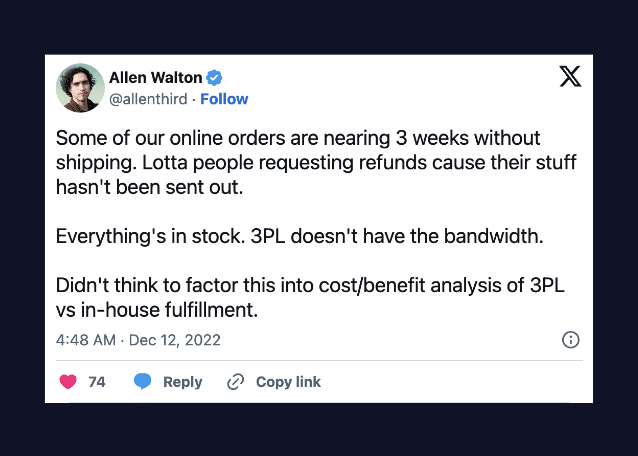

As you can see, things can quickly go wrong. From excitement about leaving the woes of in-house fulfillment behind, Allen has done a full 180. And in nine short months.
Which brings us onto when outsourced fulfillment might not cut it.
Why would you bring fulfillment in-house?
The reasons why you might choose to bring fulfillment back under your own control range from dissatisfaction with 3PL performance (like our friend Allen) to a desire for increased control. However, according to Kate, “the primary reason that businesses bring fulfillment in-house is costs.”
This isn’t quite as straightforward as it seems. During the COVID pandemic, many ecommerce businesses saw shifts in demand which created conditions that might not apply during normal times. Kate explains this as follows:
“Usually businesses follow a maturity curve, during the ecommerce boom that we saw during COVID lockdowns, many businesses jumped maturity levels because of the sheer increase in volumes. Suddenly they had problems associated with larger scale operations without the gradual increments normally seen when a business grows. This meant they struggled to manage the scale. To fix this, they went with a 3PL.
Now that we see demand shifting back towards pre-pandemic levels, businesses are able to retroactively go through those maturity steps. This means that, in many cases, they’re looking at the bill from their 3PL and saying, “that used to not be a problem for us, but now can go back to being lean.”
So, in a post-pandemic world, as demand trends back towards what’s considered the “norm”, businesses are able to be more strategic with how they spend their money. Growth is still happening — and businesses are still confident in the revenue that they’ll generate — but, as Kate illustrates, “they’re having to choose between purchasing more inventory to cover the growth or investing in business systems that will help them reach the level of maturity they need to be at.”
Let’s dive into the pros and cons for both outsourced and in-house fulfillment. After all, we’d hate for you to make a hasty decision.
Outsourced vs. in-house fulfillment: pros and cons
If you’re trying to make a call between outsourced and in-house fulfillment, it’s likely that you’re already facing challenges with your 3PL — or you’re spending too much with them. However, the last thing you’d want to do is jump out of the frying pan and into the fire.
Here are the pros and cons associated with each model, to help that decision along:
Advantages of outsourcing fulfillment
One of the biggest benefits of outsourcing to a 3PL lies in access to specialized expertise. Fulfillment providers employ professionals adept at managing logistics intricacies, ensuring efficient operations.
Outsourcing also offers flexibility. Businesses can adapt to market fluctuations swiftly without the constraints of hiring or reducing staff, which can be tricky.
Another key benefit of outsourcing fulfillment to a 3PL is delegating inventory management; by using a third party, it’s likely that you never have to even touch inventory — it is shipped straight from suppliers to your 3PL’s warehouse, meaning you never have to touch it.
Disadvantages of outsourcing fulfillment
Outsourcing fulfillment does come with its share of drawbacks. The primary concern is costs. According to Kate, “Because 3PL’s specialize in managing fulfillment, they know what touches are needed to inventory and when. This philosophy means that anytime they touch their client’s stuff, they’re going to charge for it.” These charges can soon mount up.
Another core draw-back of outsourcing is reduced control. Entrusting a 3PL center means relinquishing control over essential aspects of the fulfillment process. This lack of control can lead to issues like inconsistent quality, delayed customer support responses, and challenges in implementing personalized branding initiatives.
Dependency on third parties is another thorn in outsourcing’s side. Businesses relying on external fulfillment providers are vulnerable to disruptions caused by fulfillment center errors, labor strikes, or policy changes, all of which can impact the brand’s reputation negatively.
Advantages of in-house fulfillment
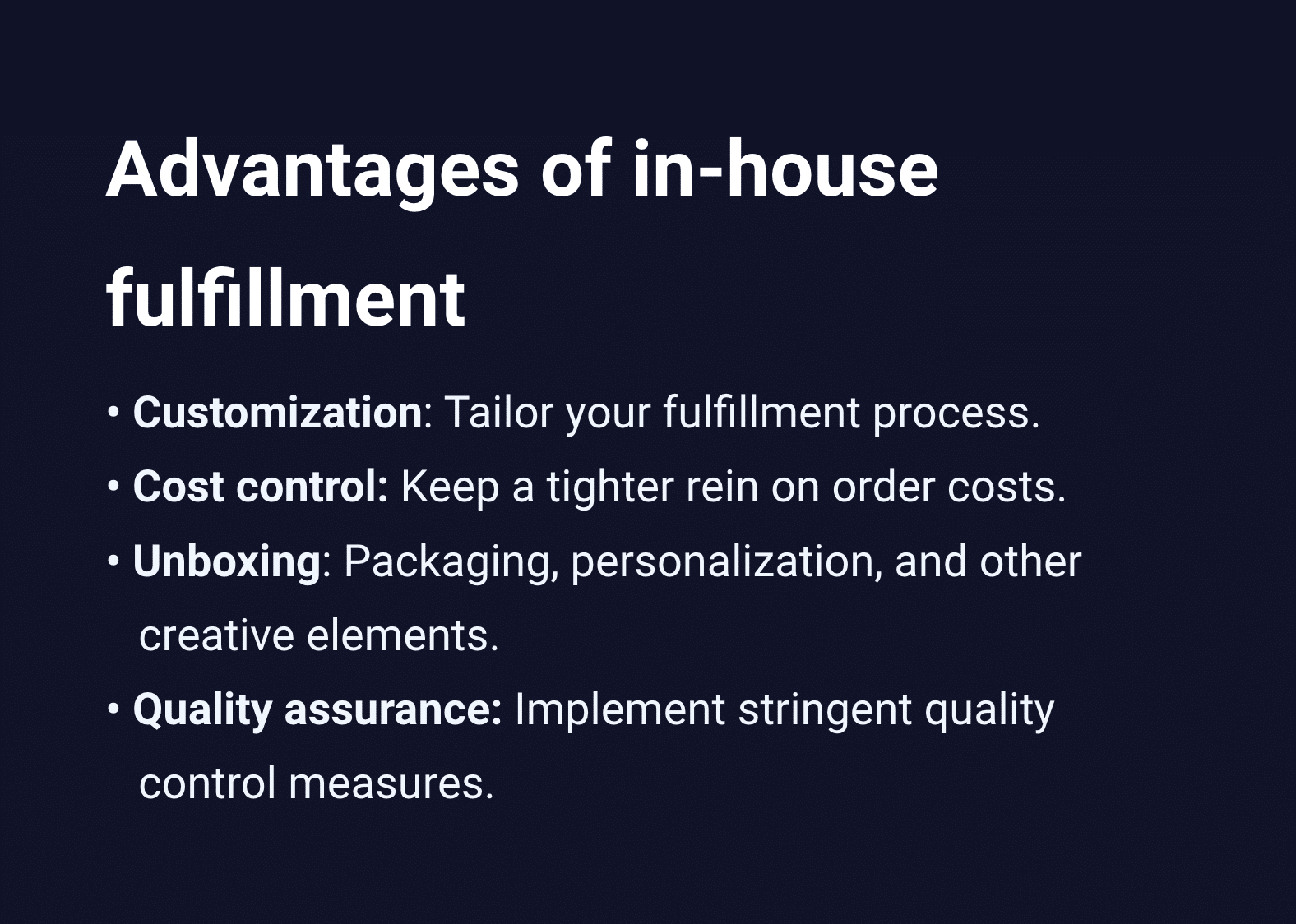

By contrast, in-house fulfillment provides businesses with greater control and customization options. You’re able to tailor your fulfillment processes to meet unique requirements. This level of control extends to aspects such as packaging, branding, and customer communication, enabling you to create a consistent and memorable brand experience.
Additionally, in-house fulfillment allows for greater cost control. By taking control of your fulfillment processes, you’re able to keep a tighter rein on how much an order is costing you to process, and project forwards with greater certainty.
You’re also able to implement specific packaging designs, personalized notes, and other creative elements, enhancing the unboxing experience for customers. Quality assurance is another significant advantage. With in-house fulfillment, it’s possible to implement stringent quality control measures, ensuring every product shipped meets your standards.
Disadvantages of in-house fulfillment
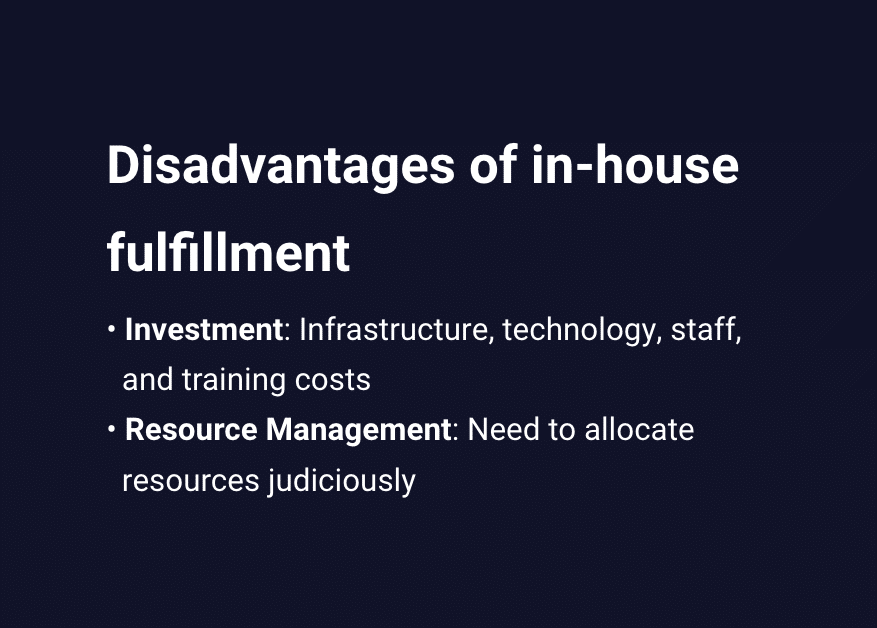
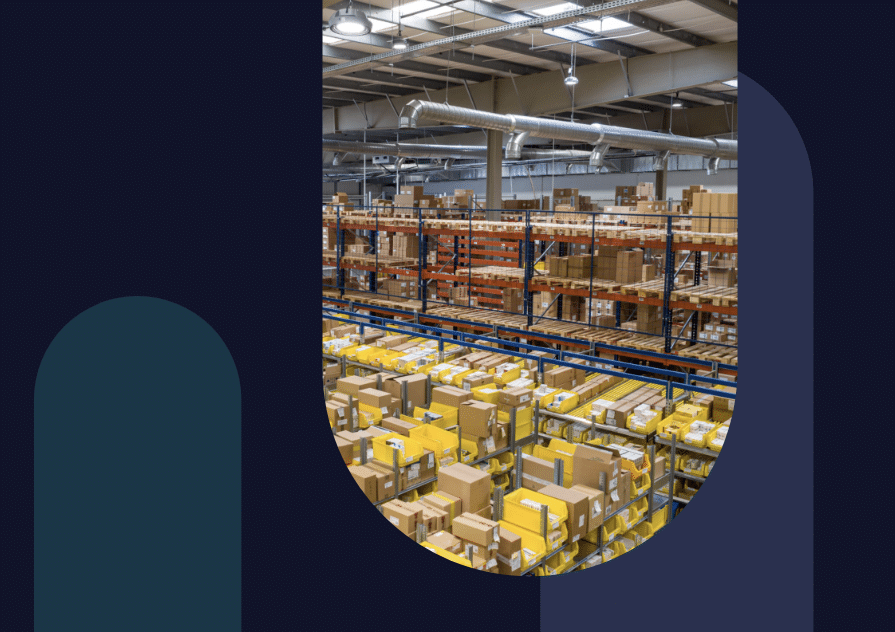
However, transitioning to in-house fulfillment is not without its challenges. The most significant hurdle is the initial investment required. Setting up an in-house fulfillment operation involves costs related to infrastructure, technology, staffing, and training. For small and medium-sized businesses with limited capital, this initial investment can pose a substantial barrier.
Efficient resource management is another challenge. When bringing things back in-house, you need to allocate resources judiciously, balancing the demands of fulfillment operations with other critical aspects such as marketing, customer service, and product development. Poor resource management can lead to inefficiencies, missed deadlines, and increased operational costs.
Factors to consider when bringing fulfillment in-house
When it comes to the core factors to consider when bringing fulfillment in-house, Kate explains that these can be broken into three categories — people, space, and systems. Let’s consider each of these in detail:
People
“Labor is one of the biggest challenges that small and medium sized businesses have right now. For them, primarily, the first factor to consider is going to be, “do I have people to do the work?”” says Kate.
In-house fulfillment operations require a dedicated and skilled workforce. Hiring the right employees is critical. Seek out people with relevant experience in warehouse operations, order processing, and inventory management.
And then train them well. New team members need comprehensive training to familiarize themselves with the business’s processes, quality standards and safety protocols. Continuous training ensures employees stay updated on best practices and can adapt to changing requirements.
Space
“Secondary to labor, or maybe in line with it, a key consideration is, “do I have a space where fulfillment work needs to happen” says Kate.
She continues, “I think it depends on the maturity of the business, but generally if somebody has been using a 3PL and they want to bring it in house, they’re generally not a start-up, running-out-of-their-garage business. They usually either have a warehouse or they’ve decided to buy one. And that probably happened in line with the decision to bring fulfillment in house.”
Warehousing represents a significant investment, but is a vital consideration for any business looking to move away from 3PL and manage fulfillment themselves.
Systems and Infrastructure
Last, but by no means least, are the business services, systems, and technology needed to support your in-house fulfillment operation. Kate acknowledges the interesting dynamic here — with business services as often “being purchased at the end of a business’ tech stack.”
This is curious, as vital tools — such as Linnworks (ahem) — “sit in the middle of an inventory’s life cycle. Businesses often come to us with a lot of their tech stack already built. Thankfully, owing to our extensive partner network and the fact that we connect to a lot of different places, we’re an easy choice for somebody who already has systems in place. What’s more, having reliable and easy to navigate systems will allow quick onboarding of new or seasonal employees, setting them, and your business, up for success as quickly as possible.”
Linnworks integrates seamlessly with the majority of existing shipping solutions and marketplaces, equipping businesses with everything they need to manage and scale in-house fulfillment processes. Which is a nice segue — what does implementing in-house fulfillment successfully look like?
Implementing in-house fulfillment successfully
Transitioning to in-house fulfillment is a multifaceted process that demands meticulous planning and execution. It’s a high-stakes maneuver, and getting it right involves a series of strategic steps.
Setting up a streamlined fulfillment process
Creating a streamlined fulfillment process is the cornerstone of successful in-house fulfillment.
You need to optimize every stage, from order processing and inventory management to packaging and shipping. Implementing automation is key to enhancing efficiency and reducing errors.
Warning! Pitch incoming!
Linnworks, with its advanced automation features, can significantly streamline the fulfillment process. Our platform automates order processing, updates inventory levels in real time, generates shipping labels, and provides detailed analytics. By centralizing operations through Linnworks, businesses can eliminate manual errors, improve order accuracy, and enhance overall productivity.
What’s more, Linnworks integrates seamlessly with various ecommerce platforms and marketplaces, allowing you to manage orders from multiple channels effortlessly. The platform’s scalability ensures it can adapt to the growing needs of businesses, making it an invaluable asset for in-house fulfillment.
Now that that’s out of the way, let’s move on to the next crucial step: timing.
In-house fulfillment: A necessary step — when the time’s right
Choosing between outsourced and in-house fulfillment is an important crossroad.
Outsourcing is convenient and flexible, but it means less control and relying on others, which might affect your brand. On the flip side, in-house gives you full control and customization, yet it’s more demanding on your resources. The right choice will likely shift as your business evolves, and a lot depends on timing — and timing looks different from business to business. But, if you’re asking yourself the question “Should I bring fulfillment in-house?” then the chances are it’s time to get planning!
Interested in bringing fulfillment in-house — but want to manage the complexity? Let Linnworks lend a hand. Book a free consultation today and find out more.